Lallart M. Ferroelectrics: Characterization and Modeling
Подождите немного. Документ загружается.

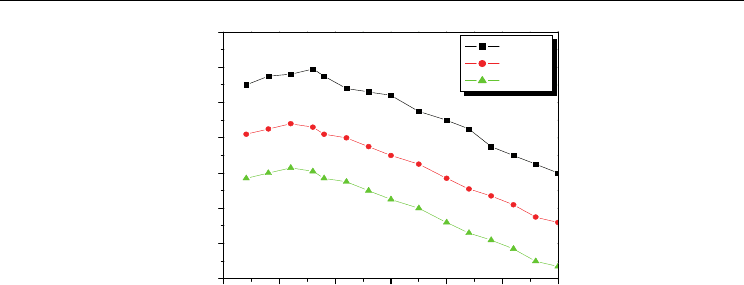
The Ferroelectric Dependent Magnetoelectricity in Composites
279
0 1000 2000 3000 4000 5000 6000
720
740
760
780
800
820
840
860
x=0.15
x=0.30
x=0.45
(dE/dH)
H
μV/cm.Oe
H (Oe)
Fig. 16. Magnetic field dependent variation of ME voltage coefficient at room temperature
for (x) Ni
0.5
Zn
0.5
Fe
2
O
4
+ (1-x) Pb
Zr
0.8
Ti
0.2
O
3
ME composites
8. Conclusion
In the study of ME effect, initially ME voltage coefficient (dE/dH)
H
increases with the
increase in applied DC magnetic field and thereafter decreases linearly. It is attributed to the
increase in elastic interaction caused by magnetostriction and piezoelectric effect aswell as
low leakage of currents and high degree of polarization.
1. ME output depends on the resistivity and mole percentage of ferrite/ferroelectric
phases and maximum ME output is observed for high resistivity composites. The
decrease in dielectric constant with frequency shows the dielectric dispersion at lower
frequency region.
2. ME output increases with decrease in the grain size of the individual phases. However,
large particles are less effective in inducing piezoelectric and piezomagnetic effect
compared to smaller grains. The composites having high porosity exhibit better ME
response, because the pores provides resistance to the electrons.
3. The present ME composites having large ME response vary linearly with DC electric
field in the low and high magnetic field regions and are attractive for technological
applications for ME devices.
The content of ferroelectric is very important for getting high ME voltage coefficient. But in
order to obtain still better ME response, one can use layered (bilayer layer and multilayer)
composites of two phases (ferrites and ferroelectrics) and it requires minimum deficiencies
with particles of nano size.
9. Acknowledgement
The authors are thankful to Prof. B K Chougule, former head Department of Physics, Shivaji
University, Kolhapur and Dr. R B Pujar, former, Principal, S S Arts and T P Science Institute
Sankeshwar for fruitful discussions.
10. References
[1] Pawar. D. V. (1995). Bull. Mater. Sci. 18 141
[2] Srinivasan. G, Rasmussen. E. T, Levin. B. J & Hayes. R. (2003). Phy. Rev. B. 65 134402

Ferroelectrics - Characterization and Modeling
280
[3] Hummel. R. E, (2004). Electronic Properties of Materials, III edition, Spinger Publication
[4] Kanai. T, Ohkoshi. S. I, Nakajima. A, Wajanabe. T & Hashimoto. K. (2001). Adv. Mater. 13
487
[5] Suryanarayana. S. V. (1994). Bull. Mater. Sci. 17 (7) 1259
[6] Boomagaard. J. V & Born. R. A. J. (1978). J. Mater. Sci. 13 1538
[7] Takada. T & Kiyama. M. (1970). Ferrite. Proceed. Internl. Conf. Japan 69
[8] Sato. T, Kuroda. C & Sato. M. (1970). Ferrite. Proceed. Internl. Conf. Japan 72
[9] Bragg. W. L. (1915). Nature. (London) 95 561
[10] Goodenough. J. B. (1963). Magnetism and Chemical Bond. Interscience, New York
[11] Paulus. M. (1962). Phys. Stat. Solidi (a). 2 1181
[12] Bammannavar. B. K, Naik. L. R & Chougule. B. K. (2008). J. Appl. Phys. 104 064123.
[13] Choudharey. R. N. P, Shannigrahi. S. R & Singh. A. K. (1999). Bull. Mater. Sci. 22 (6) 75
[14] Boomgaard. J. V &Born. R. A. J. (1978). J. Mater. Sci. 13 1538
[15] Bammannavar. B. K, Chavan. G. N, Naik. L .R & Chougule. B. K. (2009). Matt. Chem.
Phys. 11 746
[16] Bammannavar. B. K & Naik. L. R. (2009). Smart. Mater. Struct. 18 085013
[17] Devan. R. S, Kanamadi. C. M, Lokare. S. A & Chougule. B. K. (2006). Smart. Mater.
Struct. 15 1877
[18] Maxwell. J. C. (1973). Electricity and Magnetism. Oxford University Press, London
[19] Wagner. K. W. (1913). Ann. Physik. 40 817
[20] Vishwanathan. B & Murthy. V. R. K. (1990). Ferrite Materials: Science and Technology
.(New Delhi; Narosa Publishing House)
[21] Iwauchi. K. (1971). Japn. J. Appl. Phys. 10 152
[22]
Hiroshima. T, Tanaka. K & Kimura. T. (1996). J. Am. Ceram. Soc. 79 3235
[23] Austin. I. G & Mott. N. F. (1996). Adv. Phys. 18 411
[24] Alder. D & Feinleib. J. (1970). Phys. Rev. B. 2 3112
[25] Ryu. J, Priya. S, Uchino. K & Kim. H. (2002). J. Electroceram. 8 107
[26] Devan. R. S, Lokare. S. A, Patil. D. R, Chougule. S. S, Kolekar. Y. D & Chougule. B. K.
(2006). J. Phys. Chem. Solids. 67 1524
[27] Bammannavar. B. K & Naik. L. R. (2009). J. Magn. Magn, Mater. 321 382
15
Characterization of Ferroelectric
Materials by Photopyroelectric Method
Dadarlat Dorin
1
, Longuemart Stéphane
2
and Hadj Sahraoui Abdelhak
2
1
National R&D Institute for Isotopic and Molecular Technologies Cluj-Napoca,
2
University Lille Nord de France, ULCO, Dunkerque,
1
Romania
2
France
1. Introduction
During last decades, the photothermal techniques have been largely applied to the study of
thermal and optical properties of condensed matter. Photothermal techniques are based on
the same physical principle: the optical energy, absorbed by given material, is partially
converted into heat; depending on the way used to measure the quantity of heat and to
follow its propagation through the material, several photothermal techniques have been
developed (photoacoustic calorimetry, photothermal radiometry, photothermal deflection,
thermal lensing, photopyroelectric method) (Tam, 1986). In this chapter we will focus on the
simplest one, the photopyroelectric calorimetry and its applications concerning the
investigation of some thermal and electrical properties of ferroelectric materials.
The photopyroelectric (PPE) detection was introduced in 1984, as a powerful tool for high-
resolution measurement of thermal properties of materials (Coufal, 1984; Mandelis, 1984).
The pyroelectric effect consists in the induction of spontaneous polarization in a
noncentrosymmetric, piezoelectric crystal, as a result of temperature change in the crystal.
Single crystals as LiTaO
3
and TGS, ceramics as PZT or polymers as PVDF were used as
pyroelectric sensors, for the main purpose of measuring temperature variations. In
principle, in the PPE method, the temperature variation of a sample exposed to a modulated
radiation is measured with a pyroelectric sensor, situated in intimate thermal contact with
the sample (Mandelis & Zver, 1985; Chirtoc & Mihailescu, 1989). The main advantages of
this technique were found to be its simplicity, high sensitivity, non-destructive character
and adaptability to practical restrictions imposed by the experimental requirements.
From theoretical point of view, in the most general case, the complex PPE signal depends on
all optical and thermal parameters of the different layers of the detection cell. A large effort
was dedicated in the last decades to simplify the mathematical expression of the PPE signal.
As a final result, several particular cases were obtained, in which the information is
contained both in the amplitude and phase of the PPE signal (Mandelis & Zver, 1985;
Chirtoc & Mihailescu, 1989); the amplitude and phase depend in these cases on one or, in a
simple way, on two of the sample's related thermal parameters.
The thermal parameters resulting directly from PPE measurements are usually the thermal
diffusivity and effusivity. It is well known that the four thermal parameters, the static volume
specific heat, C, and the dynamic thermal diffusivity, α , conductivity, k, and effusivity, e, are
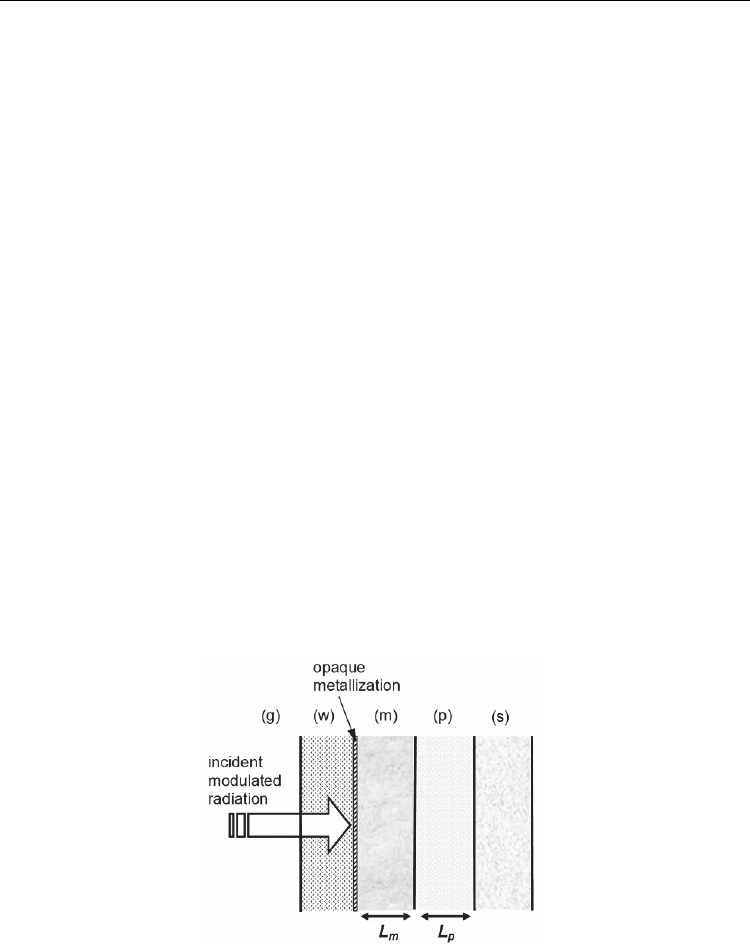
Ferroelectrics - Characterization and Modeling
282
connected by two relationships, k=C
α
and e=(Ck)
1/2
; in conclusion, only two are independent. It
is important to note that the PPE calorimetry is (at the authors knowledge) the only technique
able to give in one measurement the value of two (in fact all four) thermal parameters.
Consequently, it is obvious that the PPE method is suitable not only to characterize from
thermal point of view a large class of solids and liquids, but also to study processes
associated with the change of the thermal parameters as a function of temperature (phase
transitions, for example), composition (chemical reactions), time (hygroscopicity), etc.
A particular application of the PPE calorimetry is the characterization of the ferroelectric
materials. The application is particular in this case because many ferroelectric materials are
in the same time pyroelectric materials. Consequently the investigated ferroelectric
specimen can be inserted in the PPE detection cell, both as sample or (sometimes) as
pyroelectric sensor, offering additional possibilities for thermal characterization.
This chapter makes a brief summary of the theoretical and experimental possibilities offered
by the PPE calorimetry in thermal characterization of some ferroelectric materials; the
advantages and the limitations of the technique, as well as a comparison with other
techniques are presented.
2. Development of the PPE theoretical aspects concerning the thermal
characterization of ferroelectric materials
From theoretical point of view, there are two PPE detection configurations, "back" and
"front", mainly applied for calorimetric purposes. In the back (BPPE) configuration, a
modulated light impinges on the front surface of a sample, and a pyroelectric sensor,
situated in good thermal contact with the sample's rear side, measures the heat developed in
the sample due to the absorption of radiation. In the front (FPPE) configuration, the
radiation impinges on the front surface of the sensor, and the sample, in good thermal
contact with its rear side, acts as a heat sink (Mandelis & Zver, 1985; Chirtoc & Mihailescu,
1989). The geometry of the BPPE and FPPE configurations is presented in Fig.2.1.
Fig. 2.1 Schematic diagram of the PPE detection cell: (g) – air, (w) – window, (m) – material,
(p) – pyroelectric sensor, (s) – substrate.
In the BPPE configuration the ferroelectric sample is represented by the “material” (m)
layer; in the FPPE configuration, the “material” layer is missing, and the investigated
material is the pyroelectric sensor itself.

Characterization of Ferroelectric Materials by Photopyroelectric Method
283
2.1 Ferroelectric material inserted as sample in the detection cell (“back” detection
configuration)
With the additional simplifying assumptions that the window and substrate are thermally
thick, the air and window are optically transparent and the incident radiation is absorbed
only at the window-material interface (by a thin opaque layer), the PPE voltage is given by
(Delenclos et al., 2002):
)2())exp()exp(()exp()exp(
)1()exp()exp(
)1)(1(
)exp(2
0
mmwmppsppp
mp
ppmpsppp
spppsppp
mpwm
mm
LRLRLRLRRL
RLRL
bb
LV
V
σσσσσ
σσ
σ
−−−+−−−
+−−+−
×
++
−
=
(2.1)
where
(1)/(1)
jk jk jk
Rb b=− +
;
kjjk
eeb /= ;
()
jj
ai+= 1
σ
; μ= (2
α
/ω)
1/2
(2.2)
In Eq. (2.1), V
0
is an instrumental factor, R
jk
represents the reflection coefficient of the
thermal wave at the ‘jk’ interface, ω is the angular chopping frequency and σ and a are the
complex thermal diffusion coefficient and the reciprocal of the thermal diffusion length (a =
1/μ), respectively. In order to eliminate V
0
, a normalization of the signal is necessary, the
best reference signal being obtained by the direct illumination of the empty sensor. The
obtained normalized signal is:
)()exp(
)1)(1(
)1(2
)( fPL
bb
b
fV
mm
mpwm
gp
n
σ
−
++
+
=
(2.3)
where
1exp(2)
()
1 exp( 2 ) [ exp( 2 )] exp( 2 )
sp gp p p
s
p
m
ppp
m
p
s
ppp
wm m m
RR L
Pf
RR L R R L R L
σ
σσσ
−−
=
−−+−− −
(2.4)
If we work in the thermally thick regime for the sensor (L
p
>> μ
p
) and we extract the phase
and the amplitude from Eq. (2.3), we get for the phase:
[]
−−
−+
−=Θ
)2exp( 1
)2exp( 1)tan(
arctan
mm
mmmm
LaR
LaRLa
(2.5)
with R = R
mw
R
mp ,
and for the amplitude:
mm
mpwm
gp
n
La
bb
b
V −
++
+
= )
)1)(1(
)1(2
lnln
(2.6)
An analysis of Eq. (2.5) indicates that the sample’s thermal diffusivity (contained in a
m
) can
be directly measured by performing a frequency scan of the phase of the PPE signal. The
most suitable particular case seems to be the thermally thick regime for the sample, (L
m
>>
μ
m
), when Eqs. (2.5) and (2.6) reduce to:
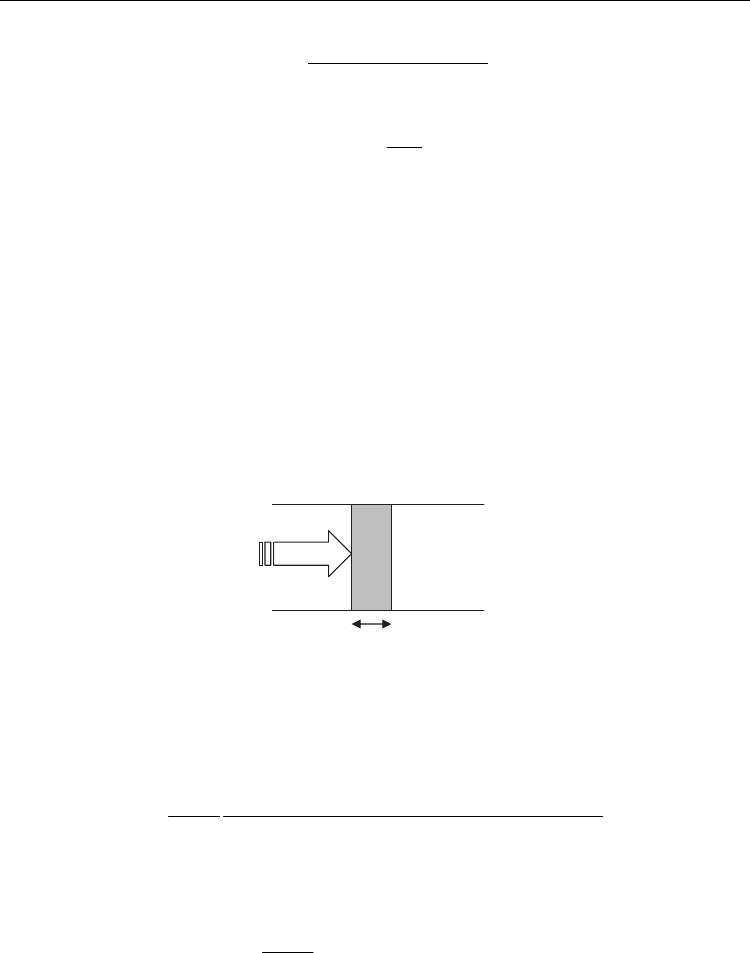
Ferroelectrics - Characterization and Modeling
284
()
1/2
0
exp /2
mm
n
pm
L
VV
ee
ωα
−
=
+
; (2.7)
2/1
0
2
−Θ=Θ
m
m
L
α
ω
. (2.8)
Inserting the value of the thermal diffusivity from Eq. (2.8) in Eq. (2.7) we obtain the value of
the thermal effusivity, and, using then the well known relationships between the thermal
parameters, we get the values of the remaining two thermal parameters, volume specific
heat and thermal conductivity.
2.2 Ferroelectric material inserted as sensor in the detection cell (“front” detection
configuration)
In the previous paragraph, a pyroelectric sensor was placed in thermal contact with the
studied ferroelectric sample. However, as mentioned before, it is possible to extract
information on the pyroelectric material itself. The configuration is in this case simpler,
being reduced to a three layers model: front medium-air, pyro(ferro)electric material (p)
with opaque electrodes, and a substrate (s) in good thermal contact with the pyroelectric
sensor (Fig. 2.2.).
(p) (g) (s)
L
p
Fig. 2.2 Schematic diagram of the PPE detection cell: (g) – air, (p) – pyroelectric sample, (s) –
substrate
If we consider the front medium (g) and the substrate (s) as semi-infinite (L
g
>> μ
g
and L
s
>>
μ
s
) the PPE voltage is given by :
)2exp(1
)]exp()2[exp()exp(1
1
0
ppspgp
ppppsppp
gp
LRR
LLRL
b
V
V
σ
σσσ
−−
−−−+−−
+
= . (2.9)
Considering frequencies for which the quantity
exp( 2 )
pp
L
σ
− can be neglected, the signal
expression reduces to:
)]exp()1(1[
1
0
ppsp
gp
LR
b
V
V
σ
−+−
+
=
. (2.10)
The signal can be normalized by the one obtained with empty sensor, leading to:
1(1 )exp( )
ns
ppp
VRL
σ
=− + −
. (2.11)

Characterization of Ferroelectric Materials by Photopyroelectric Method
285
The amplitude and the phase of the normalized complex signal are then expressed as:
(1 )exp( )sin( )
arctan
1(1 )exp( )cos( )
sp pp pp
s
ppppp
RaLaL
RaLaL
+−
Θ=
−+ −
; (2.12)
22
)]cos()exp()1(1[)]sin()exp()1[(
ppppspppppspn
LaLaRLaLaRV −+−+−+=
. (2.13)
In conclusion to this sub-section, the thermal diffusivity of the ferroelectric layer can be
extracted carrying out a frequency scan of the complex PPE signal. Concerning the
normalized phase (Eq. (2.12)), it has an oscillating behaviour with zero crossing at
frequencies for which a
p
L
p
is a multiple of π. The values of these frequencies allow a direct
determination of the thermal diffusivity of the ferroelectric material, providing its thickness
is known and independently on the type of substrate. The value of the thermal diffusivity
can be then used in the equation of the normalized amplitude or phase in order to obtain the
thermal effusivity of the pyro(ferro)electric layer (providing the effusivity of the substrate is
known). In addition to the thermal parameters, it is also possible to extract the temperature
dependence of the pyroelectric coefficient γ of the pyroelectric from the instrumental factor
V
0.
In current mode, it is expressed as:
pp
f
CL
Z
I
V
2
0
0
γ
−=
, (2.14)
with I
0
the intensity of the modulated light source and Z
f
the feedback complex impedance
of the current preamplifier. The normalized signal amplitude’s variation with temperature is
then proportional to γ/C
p
.
3. Instrumentation
3.1 Experimental set-up
The experimental set-up for PPE calorimetry contains some typical components (Fig. 3.1).
Fig. 3.1 Typical experimental set-up for PPE calorimetry.
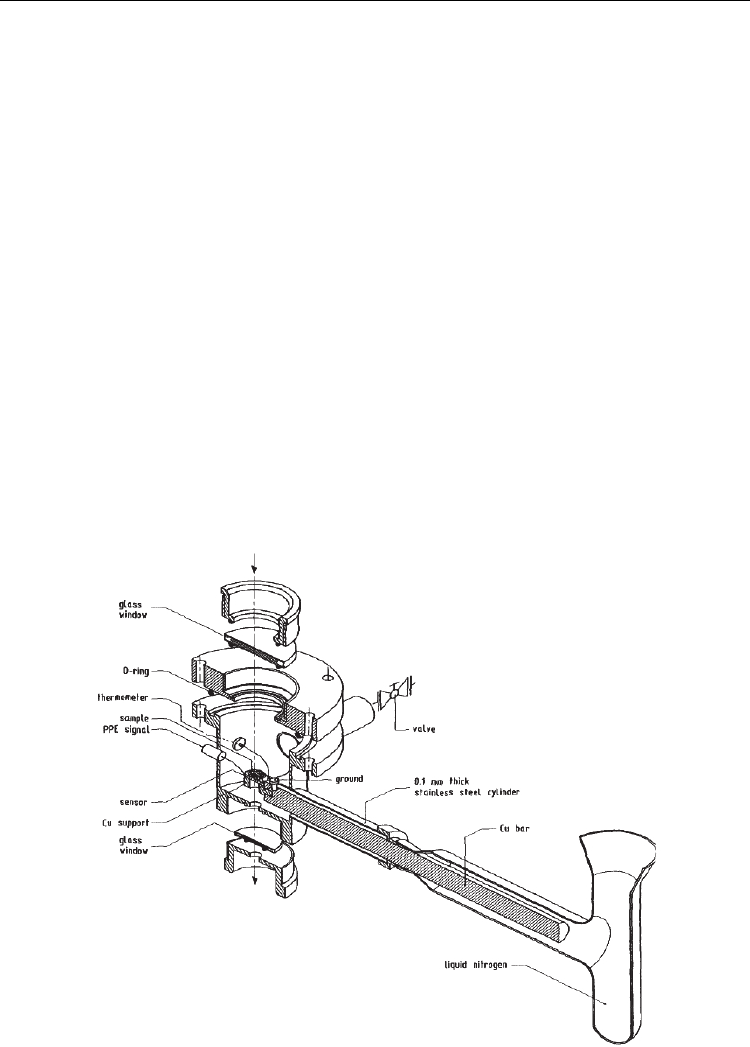
Ferroelectrics - Characterization and Modeling
286
The radiation source, usually a laser, is modulated by an acousto-optical modulator or an
electro-mechanical chopper. The PPE signal is processed with a lock-in amplifier. A
computer with adequate software is used for data acquisition. When performing
temperature scans (phase transition investigations, for example), a thermostat, provided
with Peltier elements (Jalink et al., 1996), or “cold finger” refrigerator systems (Chirtoc et al.,
2009) with additional equipment (programmable power supply, electronic thermometer,
etc.) for temperature control, is included in the set-up.
3.2 Detection cells
In the following we will describe some typical detection cells used for PPE calorimetry of
ferroelectric materials. All presented cells can operate at room temperature or can be used
for temperature scans.
3.2.1 Cold-finger cell
The cold-finger concept (Fig. 3.2) allows investigations at temperatures both below and
above the ambient. The cell is provided with two windows, for investigations in both BPPE
and FPPE configurations. In principle, the copper bar transmits the temperature to the
sample – one extremity of the bar can be cooled down by using liquid nitrogen, or heated up
electrically, with a resistive coil. The role of the 0.1 mm thick steel cylinder is to keep the cell
(excepting the copper bar) at room temperature. Depending on the operating temperature,
one can make vacuum inside the cell or introduce dry atmosphere. The temperature of the
sample is measured with a diode, glued with silicon grease to the cold finger, in the vicinity
of the sample.
Fig. 3.2 Cold finger refrigerator system
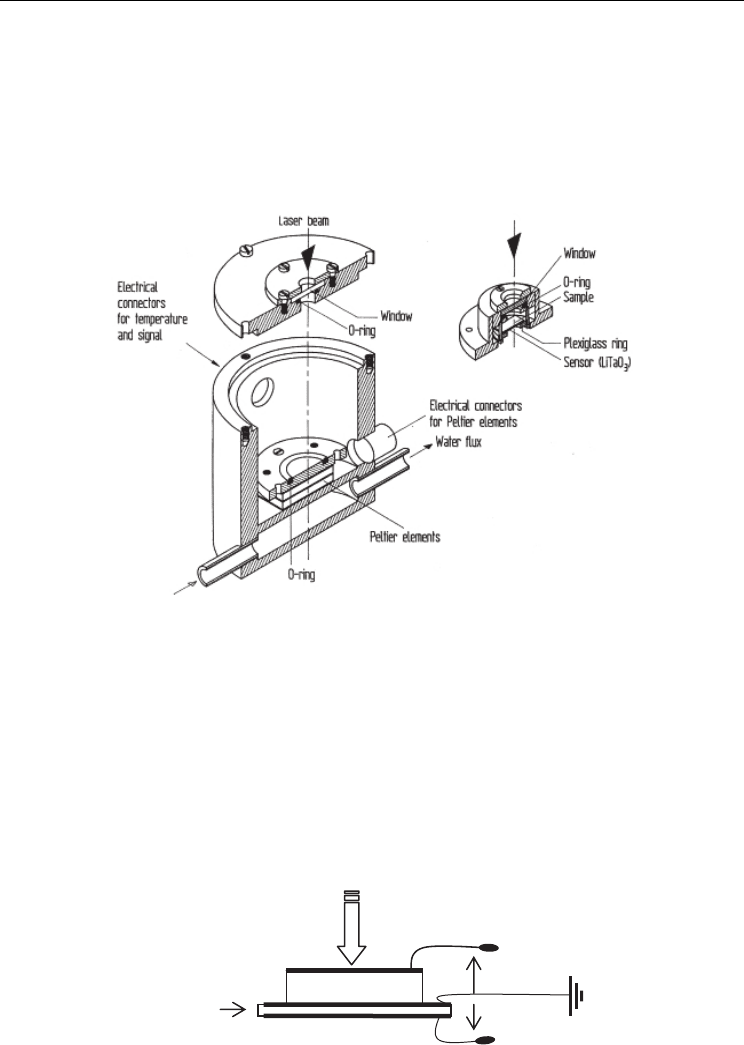
Characterization of Ferroelectric Materials by Photopyroelectric Method
287
3.2.2 Detection cell provided with Peltier elements
The design of the PPE detection cell equipped with Peltier elements is presented in Fig. 3.3.
One face of one of the two Peltier elements (electrically connected in parallel) is thermally
connected to a thermostat (liquid flux from a thermostatic bath). The opposite face of the
second Peltier element is in thermal contact with an inside-chamber that accommodates the
sample-sensor assembly. Temperature feed-back is achieved with a thermistor placed close
to the sensor. Computer-controlled temperature scans with positive/negative rates
(heating/cooling) are possible.
Fig. 3.3 PPE detection cell provided with Peltier elements
3.2.3 Application of an electric field to the sample
The electrical and thermal properties of a ferroelectric material usually depend on an
external electric field. The investigation of these properties under external electric field
requires some adaptation of the detection cell. Basically, as mentioned above, two cases
must be considered: either the ferroelectric sample is in thermal contact with a pyroelectric
sensor, either the sample is the sensor itself.
In the first case, in order to avoid the influence of the electric field on the pyroelectric signal,
a special attention must be paid for the ground of the signal: the best alternative is to use
one electrode of the sensor as a common ground for both the pyroelectric signal and the
external applied voltage (Fig. 3.4).
Fig. 3.4 Electrical connections for PPE measurement under electric field.
Applied
voltage
Pyro
signal
sample
Pyro
sensor
Optical
excitation
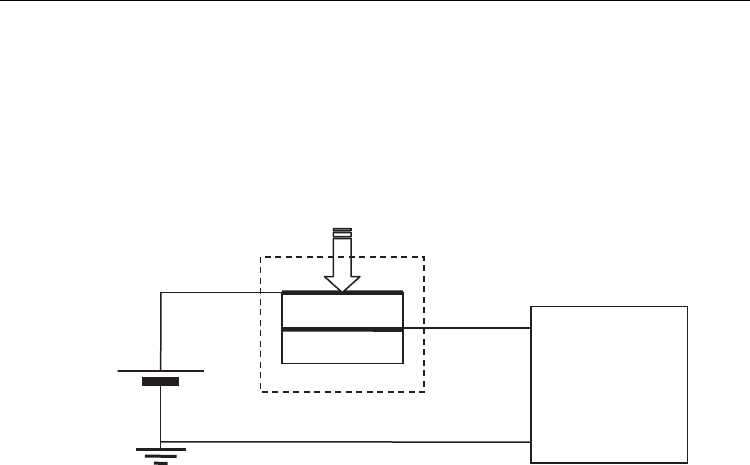
Ferroelectrics - Characterization and Modeling
288
When the investigated sample is the sensor itself, it is not possible to use the same set-up,
because the lock-in amplifier doesn’t accept high input voltage. The sample, having
usually high impedance, can be inserted in serial inside a circuit constituted of the bias
voltage power supply and the lock-in amplifier. In such a way, the input of the lock-in
amplifier is not affected by the relative high (tens of volts) applied bias voltage to the
sample (Fig. 3.5).
Fig. 3.5 Electrical arrangement for PPE measurement, when applying electric field to the
material acting as sensor.
4. Applications
4.1 Investigation of thermal parameters of ferroelectric thin films
For most of the applications concerning the ferroelectric materials, the knowledge of their
thermal parameters is necessary because they are relevant for evaluating the figure of
merit of a IR sensor (Whatmore, 1986), or a pyroelectric accelerator (Fullem and Danon,
2009) for instance. When used as a sensor in a PPE experiment, the knowledge of these
parameters is crucial, because all other measured properties depend of these values
(Bentefour et al., 2003). Moreover, it has been shown (Nakamura et al., 2010) that these
parameters have slightly different values as a function of the composition/purity of the
ferroelectric material.
In the following we consider an opaque ferroelectric material with electrodes perpendicular
to the spontaneous polarization, placed in thermal contact with a substrate, the normalized
pyroelectric voltage phase and amplitude, resulting from the periodic heating of the
material, in the front configuration, is given by the equation (2.12) and (2.13). In practice,
several approaches are possible for extracting the thermal parameters of the pyroelectric
sensor from the experimental data. We will present here the results obtained on a largely
used pyro(ferro)electric sensor: LiTaO
3
single crystal.
4.1.1 Thermal parameters extracted from the phase and amplitude, at a given
temperature
The behaviour of the normalized phase and amplitude of the PPE signal, as a function of
frequency, obtained for a 510µm thick LiTaO
3
single crystal is plotted in Fig.4.1.
Lock-In
Amplifier
substrate
sample
Optical excitation
Bias voltage
power supply
